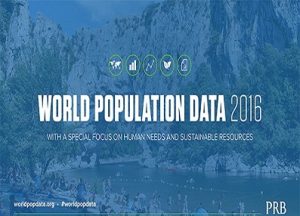According to the projections of the 2016 World Population Data Sheet from the Population Reference Bureau (PRB), the world population will reach 9.9 billion in 2050, up 33 percent from an estimated 7.4 billion now.
Regional Population Growth:-
PRB’s projections show Africa’s population will reach 2.5 billion by 2050, while the number of people in the Americas will rise by only 223 million to 1.2 billion.
- Asia will gain about 900 million to 5.3 billion, while Europe registers a decline from 740 million to 728 million. Oceania (which includes Australia and New Zealand) would rise from 40 million to 66 million.
- This data sheet provides the latest data on 19 key population, health, and environment indicators for the world, major regions, and more than 200 countries.
- PRB also added six indicators and analytical graphics that explore the balance between providing for human needs and sustainably managing the natural resources on which people depend.
Upscaled Population explosion:-
The combined population of the world’s least developed countries in the world will double by 2050 to 1.9 billion.
- The population in 29 countries wills more than double and nearly all of these countries are in Africa.
- Forty-two countries will register population declines. These countries are scattered throughout Asia, Latin America, and Europe.
- Some European countries will post significant declines, such as Romania, which is projected to have a population of 14 million in 2050, down from 20 million today.
- The population of the United States will be 398 million, up 23 percent from 324 million now.
Rate of Growth :-
As per the expected rate of growth, the expected population of the top populous countries in 2050 as follows:-
- India – 1,708 Million (1,329 in 2016)
- China – 1,344 Million (1,378 in 2016)
- US – 398 Million (324 in 2016)
- Nigeria – 398 Million (197 in 2016)
- Indonesia – 398 Million (259 in 2016)
About PRB :
The Population Reference Bureau (PRB) is a private, nonprofit organization which informs people around the world about population, health and the environment for research or academic purposes and it was founded in 1929.
- PRB was founded by Guy Burch in 1929. In the early 1930s, it shared office space with the Population Association of America in New York City.
PRB aims to have a three-fold mission:
- Inform(inform people about up-to-date research on population-related issues),
- Empower(help people put the information to use), and
- Advance(make sure that policies related to population, health, and the environment are based on sound research).
The organization focuses its work around these “core themes”: Reproductive Health and Fertility; Children and Families; Global Health; Population and the Environment; Aging; Inequality and Poverty; Migration and Urbanization; and Gender. PRB also emphasizes two Strategic Approaches: Building Coalitions and Mobilizing Civil Society.
- PRB’s annual World Population Data Sheet is a double-sided wall chart that presents data from 200 countries on important demographic and health variables such as total population, fertility rates, infant mortality rates, HIV/AIDS prevalence, and contraceptive use.
- PRB’s online Data Finder allows users to search a database of hundreds of demographic, health, economic, and environment variables for countries, world regions, and states in the United States.
- PRB’s glossary of population-related terms has been described as an authoritative source by people writing about population





